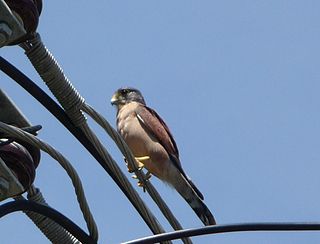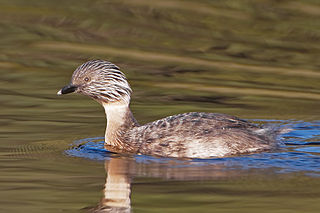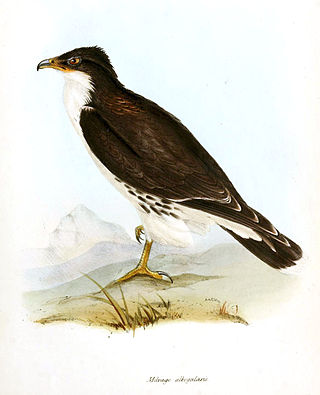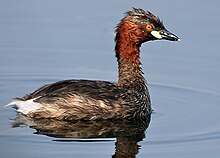
The great crested grebe is a member of the grebe family of water birds. The bird is characterised by its distinctive appearance, featuring striking black and white plumage, and elaborate courtship display that involves synchronised dances and displays.

The horned grebe or Slavonian grebe is a relatively small and threatened species of waterbird in the family Podicipedidae. There are two subspecies: P. a. auritus, which breeds in Eurasia, and P. a. cornutus, which breeds in North America. The Eurasian subspecies is distributed over most of northern Europe and northern Asia, breeding from Greenland east to the Russian Far East. The North American subspecies spans most of Canada and some of the United States. The species got its name from large patches of yellowish feathers located behind the eyes, called "horns", that the birds can raise and lower at will..

The little grebe, also known as dabchick, is a member of the grebe family of water birds. The genus name is from Ancient Greek takhus "fast" and bapto "to sink under". The specific ruficollis is from Latin rufus "red" and Modern Latin -collis, "-necked", itself derived from Latin collum "neck".

The wood sandpiper is a small wader. This Eurasian species is the smallest of the shanks, which are mid-sized long-legged waders of the family Scolopacidae. The genus name Tringa is the Neo-Latin name given to the green sandpiper by Aldrovandus in 1599 based on Ancient Greek trungas, a thrush-sized, white-rumped, tail-bobbing wading bird mentioned by Aristotle. The specific glareola is from Latin glarea, " gravel".

The little swift, is a small species of swift found in Africa and southwestern Asia, and are vagrants and local breeders in southern Europe. They are found both in urban areas and at rocky cliffs where they build nests in a way typical of all members of the order Apodiformes. The genus name Apus is Latin for a swift, thought by the ancients to be a type of swallow without feet. The Latin specific affinis means similar to or related to, but in this case the species that the little swift supposedly resembles is not clear from the description. A population formerly considered to be an eastern subspecies of little swift is now separated as a distinct species, the house swift.

The least grebe, an aquatic bird, is the smallest member of the grebe family. It occurs in the New World from the southwestern United States and Mexico to Argentina, and also on Trinidad and Tobago, the Bahamas and the Greater Antilles.

The Alaotra grebe, also known as Delacour's little grebe or rusty grebe, is a recently extinct grebe that was endemic to Lake Alaotra and its surrounding lakes in Madagascar. Experts say that the grebe became extinct after carnivirous fish were introduced into its native habitat.

The Seychelles kestrel is a small bird of prey belonging to the genus Falco in the falcon family, Falconidae. It is endemic to the Seychelles Islands where it is the only breeding bird of prey. It is known in Seychellois Creole as the katiti after its loud, shrill call.

Podiceps is a genus of birds in the grebe family. The genus name comes from Latin podicis, "rear-end" and ped, "foot", and is a reference to the placement of a grebe's legs towards the rear of its body.

The Madagascar grebe is a grebe found only in western and central Madagascar. The binomial name commemorates the Austrian ornithologist August von Pelzeln. It is classified as endangered by the IUCN, with a population of less than 5,000. It is threatened by habitat loss, predation by carnivorous fish, and competition with introduced species.

The striated caracara or Forster's caracara is a Near Threatened bird of prey of the family Falconidae, the falcons and caracaras. It is found in Argentina, Chile, and the Falkland Islands. In the Falklands it is known as the Johnny rook, probably named after the Johnny penguin.

The Australasian grebe is a small waterbird common on fresh water lakes and rivers in greater Australia, New Zealand and on nearby Pacific islands. At 25–27 cm (9.8–10.6 in) in length, it is one of the smallest members of the grebe family, along with the least grebe and little grebe.

The hoary-headed grebe is a member of the grebe family. It breeds in southern parts of Australia; it winters throughout the island of Tasmania. The bird takes its name from the silvery-white streaking on its black head. It is common in Australia, with a population of about 500,000. Its habitat is similar to that of the Australasian grebe.

The Brazilian ruby is a species of hummingbird in the "brilliants", tribe Heliantheini in subfamily Lesbiinae. It is endemic to Brazil.

The black-faced cormorant, also known as the black-faced shag, is a medium-sized member of the cormorant family. Upperparts, including facial skin and bill, are black, with white underparts. It is endemic to coastal regions of southern Australia.

Swinhoe's snipe,, also known as forest snipe or Chinese snipe, is a medium-sized, long-billed, migratory wader.

The wedge-tailed jery is a small bird endemic to the east of Madagascar. The species has been the cause of some taxonomic confusion, it was originally placed with the jeries in the genus Neomixis (Cisticolidae) before being placed in its own monotypic genus Hartertula, but still considered close to Neomixis. Recent research indicates it is part of an endemic Malagasy radiation currently known as the Malagasy warblers.

The rainbow-bearded thornbill is a species of hummingbird in the "coquettes", tribe Lesbiini of subfamily Lesbiinae. It is found in Colombia, Ecuador, and Peru.

The white-throated caracara or Darwin's caracara is a species of bird of prey in the family Falconidae, the falcons and caracaras. It is found in Argentina and Chile.

The Andean gull is a species in subfamily Larinae of the family Laridae, the gulls, terns, and skimmers. It is found in Argentina, Bolivia, Chile, Colombia, Ecuador, and Peru.



























